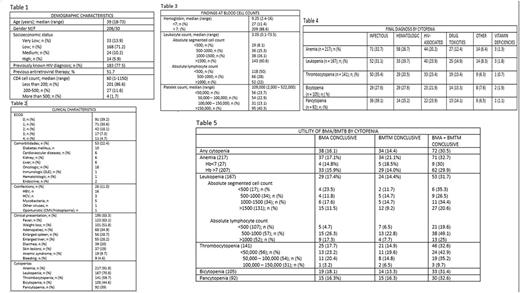Abstract
Introduction
Patients with HIV infection frequently present with low blood cell counts and need hematologic approach. Etiology is diverse, being invasive procedures frequently required to stablish a diagnosis. Currently, the role of bone marrow aspirate (BMA) and trephine bone marrow biopsy (TBMB) is not clear, as there is scarce information regarding its clinical applicability. We aimed to describe the diagnostic value of these procedures in the approach of this group of patients.
Methods
We retrospectively analyze >18 years-old HIV patients at our institute, that had one or more cytopenias according to WHO definitions and in whom BMA and TBMB were performed, from 2002 to 2015.
Results
A total 236 patients were analyzed. Median age 39 years, being 87% male. Demographic and clinical characteristics are shown at table 1 and 2 respectively. Diagnoses were grouped as: infectious (30.5%), hematologic (26.7%), HIV-related (21.2%), drugs-related (13.1%), vitamin deficiencies (1.3%), and non-diagnostic (7.2%). For the infectious diagnosis, Mycobacterium sp. infection and Histoplasma capsulatum infections were the most frequent. Non-Hodgkin lymphoma was the most prevalent hematologic diagnosis.
Anemia was present in 92%, leukopenia in 71%, thrombocytopenia in 60% and pancytopenia in 39%. Blood cell counts findings are presented at table 3. Mean time from cytopenias onset to perform BMA/TBMB was 8 days (1-63).
In patients with any cytopenia, BMA concluded a diagnosis in 16% of cases, while adding TBMB increase diagnostic rentability to 30.5%. When approaching an isolated cytopenia, BMA and BMTB stablished a diagnosis in 42.9% of cases with severe thrombocytopenia. In infectious causes presenting with pancytopenia, when bone marrow cultures where added, a diagnosis was reached in 79.5% of cases. All these data are shown at table 4 and 5.
Conclusion
To our knowledge, this is the largest series reported in the literature. The diagnostic value of BMA is low, but is considerable better when combined with TBMB, reaching a diagnosis in two thirds of HIV patients presenting with pancytopenia. Early performing of invasive diagnostic procedures in this group of patients can be the difference in stablish a correct diagnosis and initiate an adequate treatment.
No relevant conflicts of interest to declare.
Author notes
Asterisk with author names denotes non-ASH members.


This feature is available to Subscribers Only
Sign In or Create an Account Close Modal